Balancing tight budgets and high client expectations is tough.
You need to make the most of every dollar you spend.
That’s why an SEO budget plan is so important. It helps you focus your resources on the areas that will give you the best results and ROI.
In this guide, we’ll reveal how to create an SEO budget plan. You’ll learn how to make the most of your SEO spend and achieve better ROI for your clients.
We’ll cover:
- What an SEO budget plan is
- How much you should spend on SEO
- How to create an SEO budget plan
Prefer a video version? We’ve got one right here.
What Is an SEO Budget Plan?
An SEO budget plan outlines how you will spend money on search engine optimization (SEO). It breaks down the cost of the different activities you will perform as part of your SEO strategy.
The goal is to help you allocate your resources more effectively.
Without a plan, it’s easy to overspend on certain aspects or overlook important areas that need investment.
An SEO budget plan gives you a clear picture of where your money is going. It makes it easier to track ROI. And you can make more informed decisions about your SEO campaign.
If you’re selling SEO services, SEO budgeting helps you determine how much to charge your clients.
How Much Should You Spend on SEO?
There’s no one-size-fits-all answer when it comes to SEO costs. It all depends on the size of your business, goals, SEO maturity, and the competition.
If you’re in a highly competitive market, you’ll need to spend more to compete in the search engine results pages (SERPs).
In a recent survey, 28.56% of SEOs said they were working with a budget of $1,001 – $5,000:
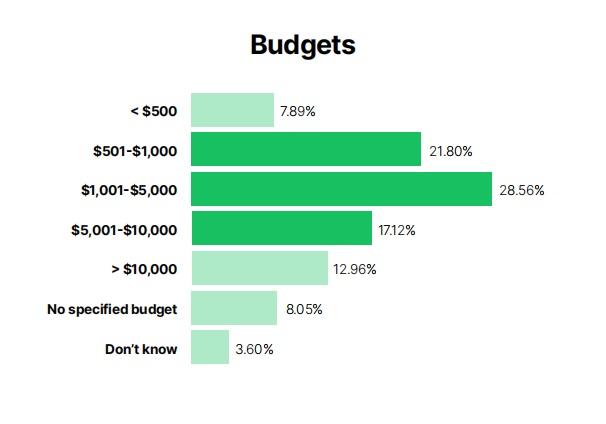
Small businesses tend to spend $500 to $2,000 per month. National businesses spend more, and enterprise clients have much bigger budgets.
Another survey found that 35.1% of marketers dedicate a ‘moderate’ percentage of their marketing budget to SEO. And a quarter spend most of their overall budget on SEO:
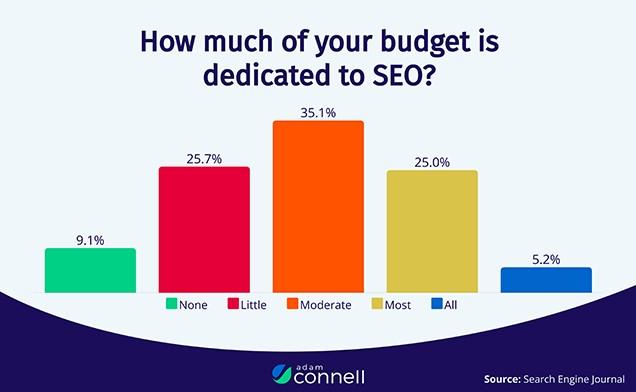
The challenge is to allocate your resources where they will make the most impact.
How to Create a Budget for SEO
Here’s how to create an SEO budget that maximizes your resources and helps you achieve your goals:
Step 1: Assess Your Current SEO Performance
First, you need to understand your current SEO performance. Knowing what’s working and what needs improvement helps you determine where to focus your budget.
You can use Google Search Console to see how much traffic you currently attract from search results. This will show you which terms you rank for and which pages are performing well.
SEO tools like Semrush and Ahrefs can help you compare your performance to competitors. Pay attention to keyword rankings and backlink profiles.
The goal is to identify the areas where you need to improve. That could involve creating more content, optimizing existing pages, and building more links.
Don’t neglect technical SEO. You can use Google Search Console and Screaming Frog to check for crawl errors, duplicate content, and other technical issues that could be impacting organic search ranking.
Step 2: Define Your Goals
Next, identify what you want to achieve with your SEO strategy.
Clear objectives will help you prioritize tactics. It helps you allocate resources where they will make the biggest impact.
Your goals should align with your overall business objectives.
In a recent Databox survey, the most common SEO goal was keyword rankings.
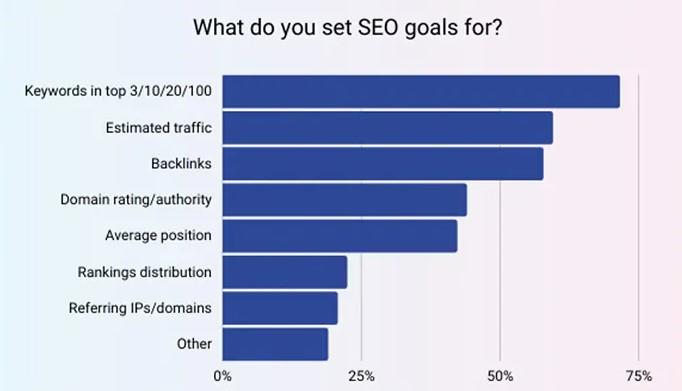
Rankings are a tangible metric for measuring progress. Traffic can fluctuate for many reasons, so it’s harder to attribute changes directly to SEO efforts.
Decide which goals are most important based on your business objectives.
For example, your client might already rank for a bunch of relevant keywords but can’t break into the first page of search results.
Setting a goal for improving their backlink profile might be more useful than ranking for more keywords.
Step 3: Prioritize Activities
The next step is to prioritize SEO activities.
A recent survey revealed that content strategy and production were the main focus for SEOs in 2023/24:
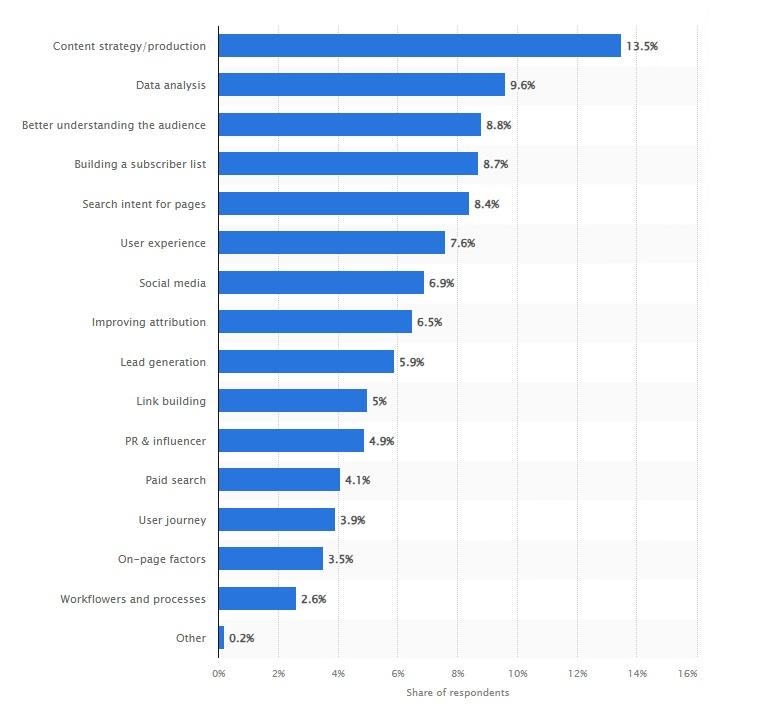
But the tactics you should focus on will depend on your current SEO performance and goals.
You also need to consider the potential impact of each activity compared to the resources required.
Some tasks can provide quick SEO wins with minimal effort. For example, you might be able to increase clickthroughs by updating meta tags and descriptions.
Others require much more resources but can deliver significant long-term benefits. A digital PR campaign is a substantial investment but can significantly boost your visibility and authority.
Rank activities based on the effort required and potential benefit. If a task requires lots of resources but doesn’t significantly move the needle, it might not be worth prioritizing.
It takes time to see the impact your SEO marketing efforts generate. For some clients, you might want to run a Google Ads campaign initially.
This helps you achieve quick results and can provide great insights for your keyword research strategy.
Step 4: Assess Your In-House Capabilities
You need to know what your marketing team can handle in-house.
Do you have someone who can create quality content that can rank?
Do you have a team member skilled in technical SEO?
You also need to consider the current workload. Even if your team has the skills, they might not have the capacity to take on additional tasks.
For example, link building is one of the most difficult parts of SEO. Building high-impact backlinks takes a lot of time and skill.
If your team lacks experience in this area, consider outsourcing to a link building specialist.
The only agency model that scales:
Insource:
👉 Sales
👉 Strategy
👉 Technical
👉 ReportingOutsource:
👉 Link Building
👉 Content
👉 Video
👉 Design— Joe Davies (@fatjoedavies) June 24, 2024
Go through your list of prioritized tasks and decide what you can handle in-house and what to outsource.
Step 5: Understand the Costs
Next, you need to assign a cost to each SEO activity. This will help you allocate your resources more efficiently.
Costs can vary depending on whether you perform them in-house or outsource.
For example, in-house link building costs include salaries, benefits, and any training or tools your team might need.
Outsourcing is much more set price. You can hire an agency or freelancer at a per-link rate for blogger outreach or niche edits.
Depending on the site’s authority and relevance, costs can range from $80 to $1,000+.
In a recent Serpstat survey, 52% of SEOs said they spent between $1,000 – $5,000 per month on link building:
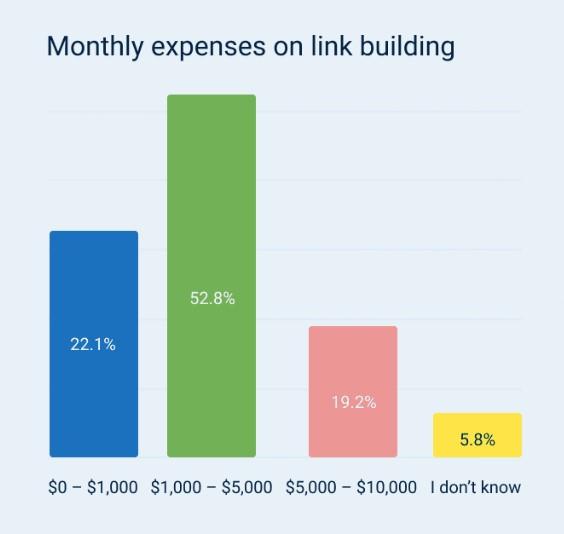
Get detailed quotes from multiple providers for any tasks you’re thinking of outsourcing.
By researching the costs, you can create a more realistic SEO marketing budget. This will help you understand the expenses involved and how to maximize your resources.
Step 6: Allocate Your Budget
With your goals, priorities, and costs down, it’s time to allocate your budget.
This step is about deciding how much money to spend on each aspect of your SEO strategy.
You can divide your budget into three main areas: on-page SEO and content marketing, off-page SEO, and technical SEO.
On-Page SEO and Content
This pillar of SEO usually takes up a significant portion of the digital marketing budget.
Content creation and optimization are ongoing tasks. It includes keyword research, content writing, updating existing content, and on-page optimization.
Generally, you should allocate around 40-50% of your budget here.
Off-Page SEO
Blogger outreach, digital PR, and other off-page SEO tactics usually account for 30-40% of SEO budgets. This will depend on the maturity of your SEO strategy.
If you’re working on a relatively new site, you might want to focus more on content creation first. Build a foundation of local citations and blogger outreach links and scale up later.
Technical SEO
Most SEO managers allocate 20-30% of their budgets to technical SEO. This covers site audits, speed optimization, mobile optimization, and fixing any technical issues.
Conducting a technical audit at the start of your SEO project is a good idea. This will help you address any issues impacting your ability to rank.
You’ll need to fix these before you can achieve results from your content creation and off-page SEO efforts.
In some cases, you might want to set aside a small portion of your budget. This gives you some flexibility to respond to unexpected opportunities and challenges.
For example, there might be some breaking news in your industry that attracts wider media attention. By quickly creating content on the trending topic, you can gain exposure and backlinks from high-authority media sites.
Step 7: Track Performance and Adjust Your Budget
SEO is not a set-it-and-forget-it task.
Once you’ve set your SEO budget, keep track of your performance to see if your strategy is paying off.
Make adjustments based on what’s working. Dedicate more of your budget to activities that generate the best results.
For example, you may find that updating your existing content is making a big impact on your ranking and helping you to drive more organic traffic. You might want to cut back on new posts and invest more in content updates.
Making the Most of Your SEO Budget
An SEO budget plan ensures every dollar you spend helps you achieve your goals.
You can allocate your resources more effectively and deliver better results for your clients.
Become a Pro at SEO
Join 65,000 others and learn the secrets to SEO success with our weekly blog posts.
